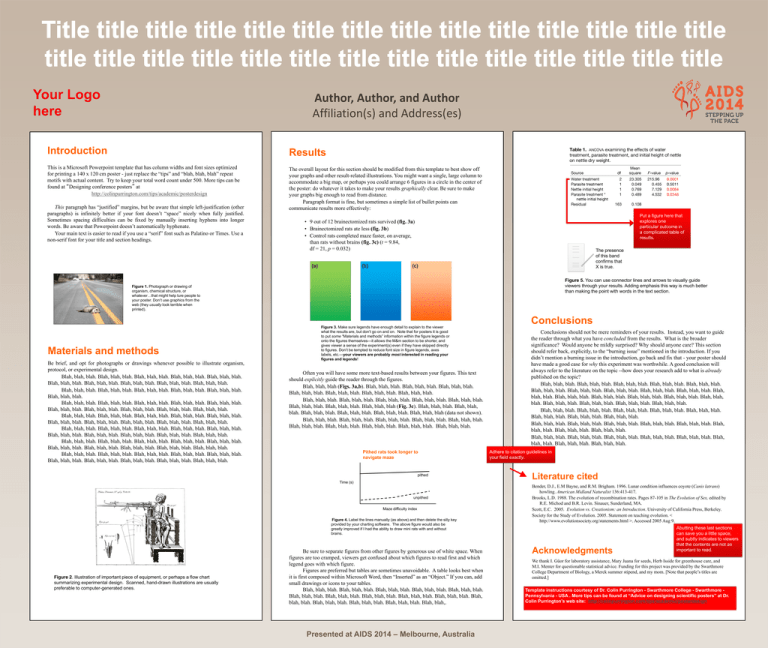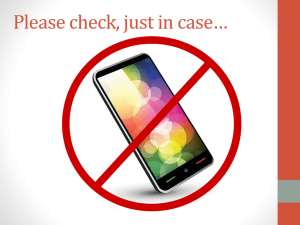
Author, Author, and Author
Affiliation(s) and Address(es)
Introduction
Results
This is a Microsoft Powerpoint template that has column widths and font sizes optimized
for printing a 140 x 120 cm poster - just replace the “tips” and “blah, blah, blah” repeat
motifs with actual content. Try to keep your total word count under 500. More tips can be
found at “Designing conference posters” at
http://colinpurrington.com/tips/academic/posterdesign
The overall layout for this section should be modified from this template to best show off
your graphs and other result-related illustrations. You might want a single, large column to
accommodate a big map, or perhaps you could arrange 6 figures in a circle in the center of
the poster: do whatever it takes to make your results graphically clear. Be sure to make
your graphs big enough to read from distance.
Paragraph format is fine, but sometimes a simple list of bullet points can
communicate results more effectively:
This paragraph has “justified” margins, but be aware that simple left-justification (other
paragraphs) is infinitely better if your font doesn’t “space” nicely when fully justified.
Sometimes spacing difficulties can be fixed by manually inserting hyphens into longer
words. Be aware that Powerpoint doesn’t automatically hyphenate.
Your main text is easier to read if you use a “serif” font such as Palatino or Times. Use a
non-serif font for your title and section headings.
Put a figure here that
explores one
particular outcome in
a complicated table of
results.
• 9 out of 12 brainectomized rats survived (fig. 3a)
• Brainectomized rats ate less (fig. 3b)
• Control rats completed maze faster, on average,
than rats without brains (fig. 3c) (t = 9.84,
df = 21, p = 0.032)
(b)
(a)
The presence
of this band
confirms that
X is true.
(c)
Figure 5. You can use connector lines and arrows to visually guide
viewers through your results. Adding emphasis this way is much better
than making the point with words in the text section.
Figure 1. Photograph or drawing of
organism, chemical structure, or
whatever…that might help lure people to
your poster. Don’t use graphics from the
web (they usually look terrible when
printed).
Materials and methods
Be brief, and opt for photographs or drawings whenever possible to illustrate organism,
protocol, or experimental design.
Blah, blah, blah. Blah, blah, blah. Blah, blah, blah. Blah, blah, blah. Blah, blah, blah.
Blah, blah, blah. Blah, blah, blah. Blah, blah, blah. Blah, blah, blah. Blah, blah, blah.
Blah, blah, blah. Blah, blah, blah. Blah, blah, blah. Blah, blah, blah. Blah, blah, blah.
Blah, blah, blah.
Blah, blah, blah. Blah, blah, blah. Blah, blah, blah. Blah, blah, blah. Blah, blah, blah.
Blah, blah, blah. Blah, blah, blah. Blah, blah, blah. Blah, blah, blah. Blah, blah, blah.
Blah, blah, blah. Blah, blah, blah. Blah, blah, blah. Blah, blah, blah. Blah, blah, blah.
Blah, blah, blah. Blah, blah, blah. Blah, blah, blah. Blah, blah, blah. Blah, blah, blah.
Blah, blah, blah. Blah, blah, blah. Blah, blah, blah. Blah, blah, blah. Blah, blah, blah.
Blah, blah, blah. Blah, blah, blah. Blah, blah, blah. Blah, blah, blah. Blah, blah, blah.
Blah, blah, blah. Blah, blah, blah. Blah, blah, blah. Blah, blah, blah. Blah, blah, blah.
Blah, blah, blah. Blah, blah, blah. Blah, blah, blah. Blah, blah, blah. Blah, blah, blah.
Blah, blah, blah. Blah, blah, blah. Blah, blah, blah. Blah, blah, blah. Blah, blah, blah.
Blah, blah, blah. Blah, blah, blah. Blah, blah, blah. Blah, blah, blah. Blah, blah, blah.
Figure 3. Make sure legends have enough detail to explain to the viewer
what the results are, but don’t go on and on. Note that for posters it is good
to put some “Materials and methods” information within the figure legends or
onto the figures themselves—it allows the M&m section to be shorter, and
gives viewer a sense of the experiment(s) even if they have skipped directly
to figures. Don’t be tempted to reduce font size in figure legends, axes
labels, etc.—your viewers are probably most interested in reading your
figures and legends!
Often you will have some more text-based results between your figures. This text
should explicitly guide the reader through the figures.
Blah, blah, blah (Figs. 3a,b). Blah, blah, blah. Blah, blah, blah. Blah, blah, blah.
Blah, blah, blah. Blah, blah, blah. Blah, blah, blah. Blah, blah, blah.
Blah, blah, blah. Blah, blah, blah. Blah, blah, blah. Blah, blah, blah. Blah, blah, blah.
Blah, blah, blah. Blah, blah, blah. Blah, blah, blah (Fig. 3c). Blah, blah, blah. Blah, blah,
blah. Blah, blah, blah. Blah, blah, blah. Blah, blah, blah. Blah, blah, blah (data not shown).
Blah, blah, blah. Blah, blah, blah. Blah, blah, blah. Blah, blah, blah. Blah, blah, blah.
Blah, blah, blah. Blah, blah, blah. Blah, blah, blah. Blah, blah, blah. Blah, blah, blah.
Pithed rats took longer to
navigate maze
pithed
Time (s)
unpithed
Maze difficulty index
Figure 4. Label the lines manually (as above) and then delete the silly key
provided by your charting software. The above figure would also be
greatly improved if I had the ability to draw mini rats with and without
brains.
Figure 2. Illustration of important piece of equipment, or perhaps a flow chart
summarizing experimental design. Scanned, hand-drawn illustrations are usually
preferable to computer-generated ones.
Be sure to separate figures from other figures by generous use of white space. When
figures are too cramped, viewers get confused about which figures to read first and which
legend goes with which figure.
Figures are preferred but tables are sometimes unavoidable. A table looks best when
it is first composed within Microsoft Word, then “Inserted” as an “Object.” If you can, add
small drawings or icons to your tables.
Blah, blah, blah. Blah, blah, blah. Blah, blah, blah. Blah, blah, blah. Blah, blah, blah.
Blah, blah, blah. Blah, blah, blah. Blah, blah, blah. Blah, blah, blah. Blah, blah, blah. Blah,
blah, blah. Blah, blah, blah. Blah, blah, blah. Blah, blah, blah. Blah, blah,.
Presented at AIDS 2014 – Melbourne, Australia
Conclusions
Conclusions should not be mere reminders of your results. Instead, you want to guide
the reader through what you have concluded from the results. What is the broader
significance? Would anyone be mildly surprised? Why should anyone care? This section
should refer back, explicitly, to the “burning issue” mentioned in the introduction. If you
didn’t mention a burning issue in the introduction, go back and fix that - your poster should
have made a good case for why this experiment was worthwhile. A good conclusion will
always refer to the literature on the topic --how does your research add to what is already
published on the topic?
Blah, blah, blah. Blah, blah, blah. Blah, blah, blah. Blah, blah, blah. Blah, blah, blah.
Blah, blah, blah. Blah, blah, blah. Blah, blah, blah. Blah, blah, blah. Blah, blah, blah. Blah,
blah, blah. Blah, blah, blah. Blah, blah, blah. Blah, blah, blah. Blah, blah, blah. Blah, blah,
blah. Blah, blah, blah. Blah, blah, blah. Blah, blah, blah. Blah, blah, blah.
Blah, blah, blah. Blah, blah, blah. Blah, blah, blah. Blah, blah, blah. Blah, blah, blah.
Blah, blah, blah. Blah, blah, blah. Blah, blah, blah.
Blah, blah, blah. Blah, blah, blah. Blah, blah, blah. Blah, blah, blah. Blah, blah, blah. Blah,
blah, blah. Blah, blah, blah. Blah, blah, blah.
Blah, blah, blah. Blah, blah, blah. Blah, blah, blah. Blah, blah, blah. Blah, blah, blah. Blah,
blah, blah. Blah, blah, blah. Blah, blah, blah.
Adhere to citation guidelines in
your field exactly.
Literature cited
Bender, D.J., E.M Bayne, and R.M. Brigham. 1996. Lunar condition influences coyote (Canis latrans)
howling. American Midland Naturalist 136:413-417.
Brooks, L.D. 1988. The evolution of recombination rates. Pages 87-105 in The Evolution of Sex, edited by
R.E. Michod and B.R. Levin. Sinauer, Sunderland, MA.
Scott, E.C. 2005. Evolution vs. Creationism: an Introduction. University of California Press, Berkeley.
Society for the Study of Evolution. 2005. Statement on teaching evolution. <
http://www.evolutionsociety.org/statements.html >. Accessed 2005 Aug 9.
Acknowledgments
Abutting these last sections
can save you a little space,
and subtly indicates to viewers
that the contents are not as
important to read.
We thank I. Güor for laboratory assistance, Mary Juana for seeds, Herb Isside for greenhouse care, and
M.I. Menter for questionable statistical advice. Funding for this project was provided by the Swarthmore
College Department of Biology, a Merck summer stipend, and my mom. [Note that people’s titles are
omitted.]
Template instructions courtesy of Dr. Colin Purrington - Swarthmore College - Swarthmore Pennsylvania - USA . More tips can be found at “Advice on designing scientific posters” at Dr.
Colin Purrington’s web site: http://colinpurrington.com/tips/academic/posterdesign









